Construction Work Safety Report: Fiona Stanley Hospital Case Study
VerifiedAdded on 2023/03/30
|18
|3059
|407
Report
AI Summary
This report provides a comprehensive analysis of construction work safety, focusing on a case study of the Fiona Stanley Hospital in Australia. The report begins with an executive summary highlighting the issues of hospital maintenance and the resulting challenges such as structural defects, outdated equipment, and potential hazards to workers. It then provides a literature review, defining maintenance, categorizing it into corrective and planned approaches, and discussing the factors affecting maintenance at the design phase. The report outlines common causes of accidents on construction sites and the importance of designing for safety, including the hierarchy of controls. It also discusses the responsibilities of stakeholders, barriers to safety programs, and the importance of promoting a safety culture. Furthermore, the report identifies different types of hazards (biological, physical, ergonomic, chemical, work organization, psychological, and safety) and explains the process of risk management. Finally, it presents a hazard assessment, identifies potential risks, and proposes an action plan with specific dates for implementation, ensuring a safer working environment. The report emphasizes the need for routine hazard assessments and compliance with legislative requirements to improve construction safety.
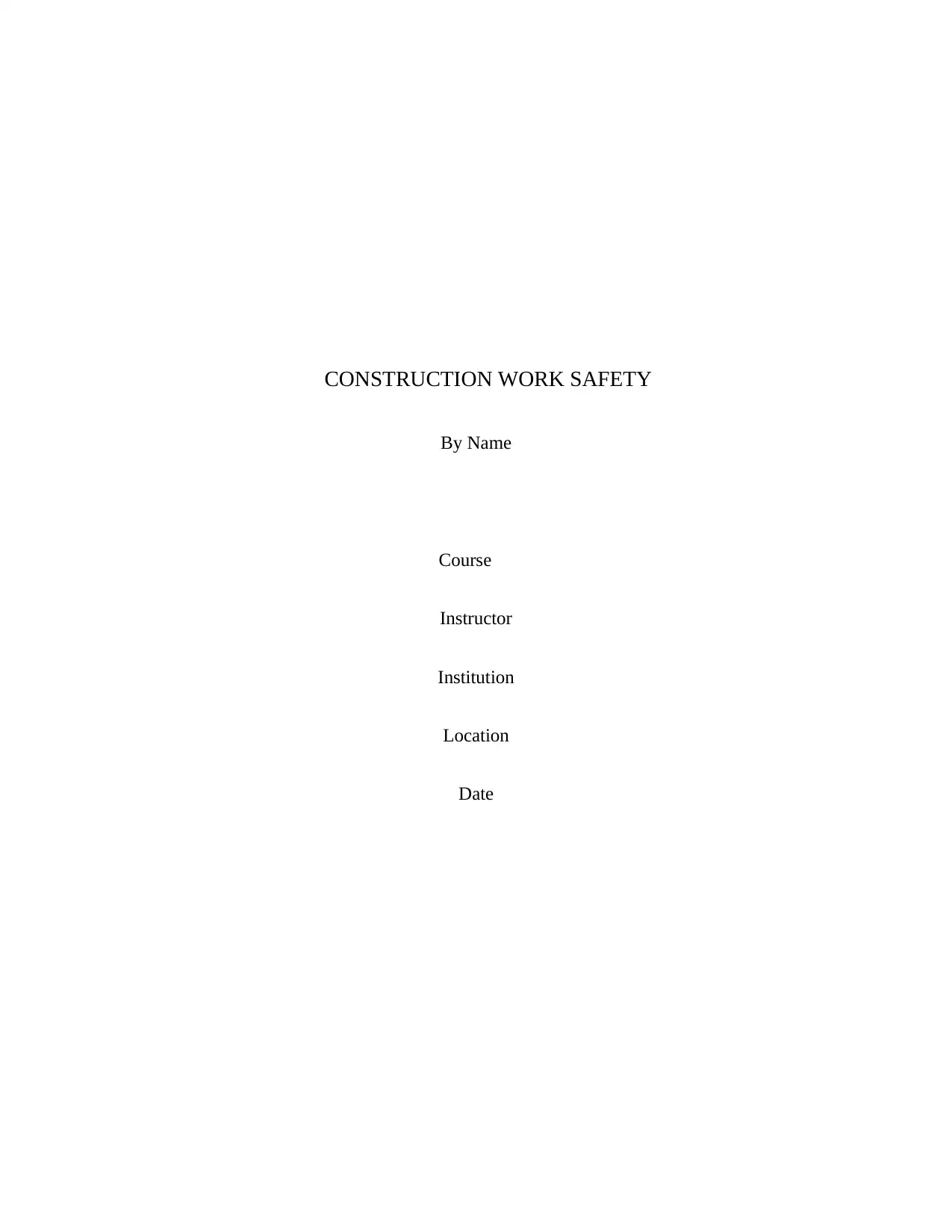
CONSTRUCTION WORK SAFETY
By Name
Course
Instructor
Institution
Location
Date
By Name
Course
Instructor
Institution
Location
Date
Paraphrase This Document
Need a fresh take? Get an instant paraphrase of this document with our AI Paraphraser
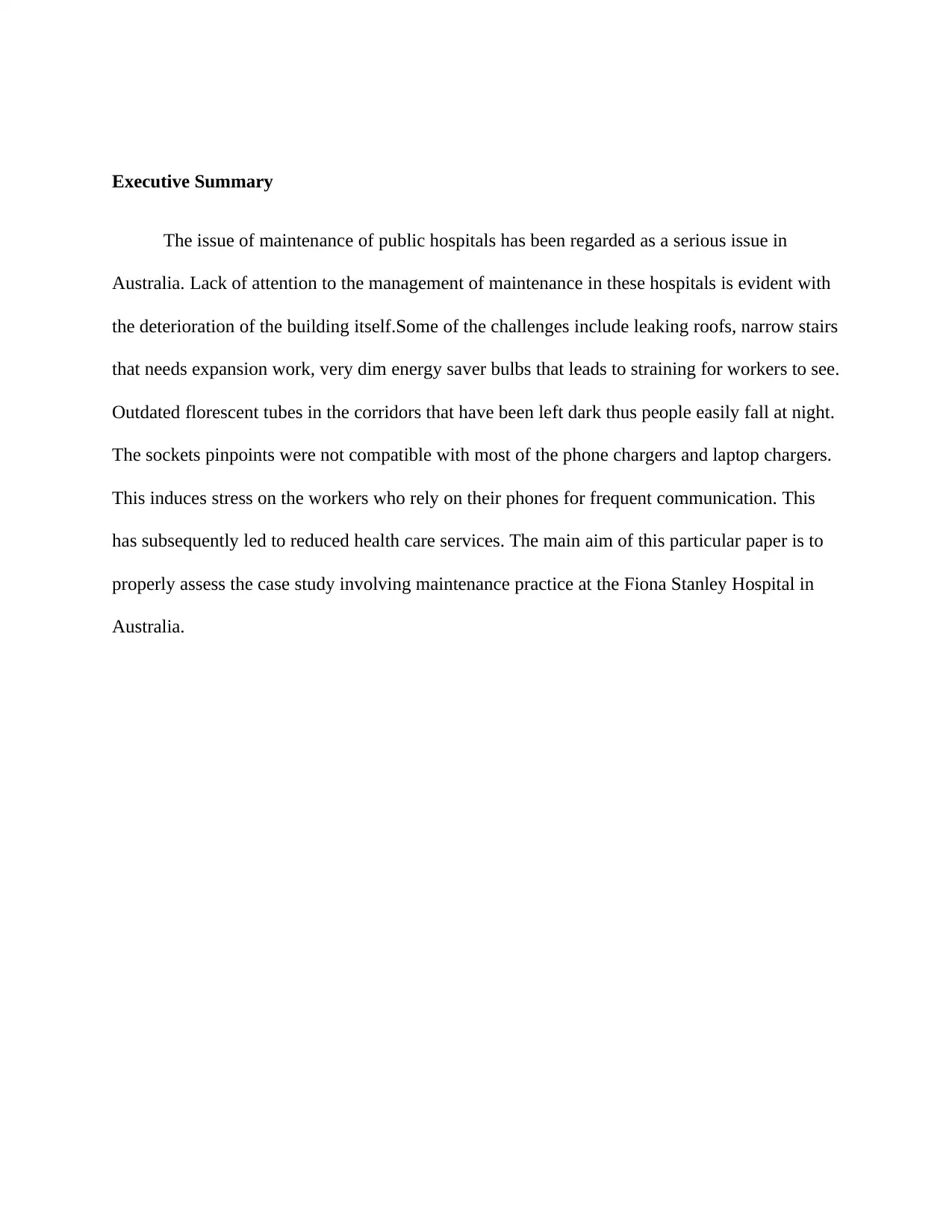
Executive Summary
The issue of maintenance of public hospitals has been regarded as a serious issue in
Australia. Lack of attention to the management of maintenance in these hospitals is evident with
the deterioration of the building itself.Some of the challenges include leaking roofs, narrow stairs
that needs expansion work, very dim energy saver bulbs that leads to straining for workers to see.
Outdated florescent tubes in the corridors that have been left dark thus people easily fall at night.
The sockets pinpoints were not compatible with most of the phone chargers and laptop chargers.
This induces stress on the workers who rely on their phones for frequent communication. This
has subsequently led to reduced health care services. The main aim of this particular paper is to
properly assess the case study involving maintenance practice at the Fiona Stanley Hospital in
Australia.
The issue of maintenance of public hospitals has been regarded as a serious issue in
Australia. Lack of attention to the management of maintenance in these hospitals is evident with
the deterioration of the building itself.Some of the challenges include leaking roofs, narrow stairs
that needs expansion work, very dim energy saver bulbs that leads to straining for workers to see.
Outdated florescent tubes in the corridors that have been left dark thus people easily fall at night.
The sockets pinpoints were not compatible with most of the phone chargers and laptop chargers.
This induces stress on the workers who rely on their phones for frequent communication. This
has subsequently led to reduced health care services. The main aim of this particular paper is to
properly assess the case study involving maintenance practice at the Fiona Stanley Hospital in
Australia.
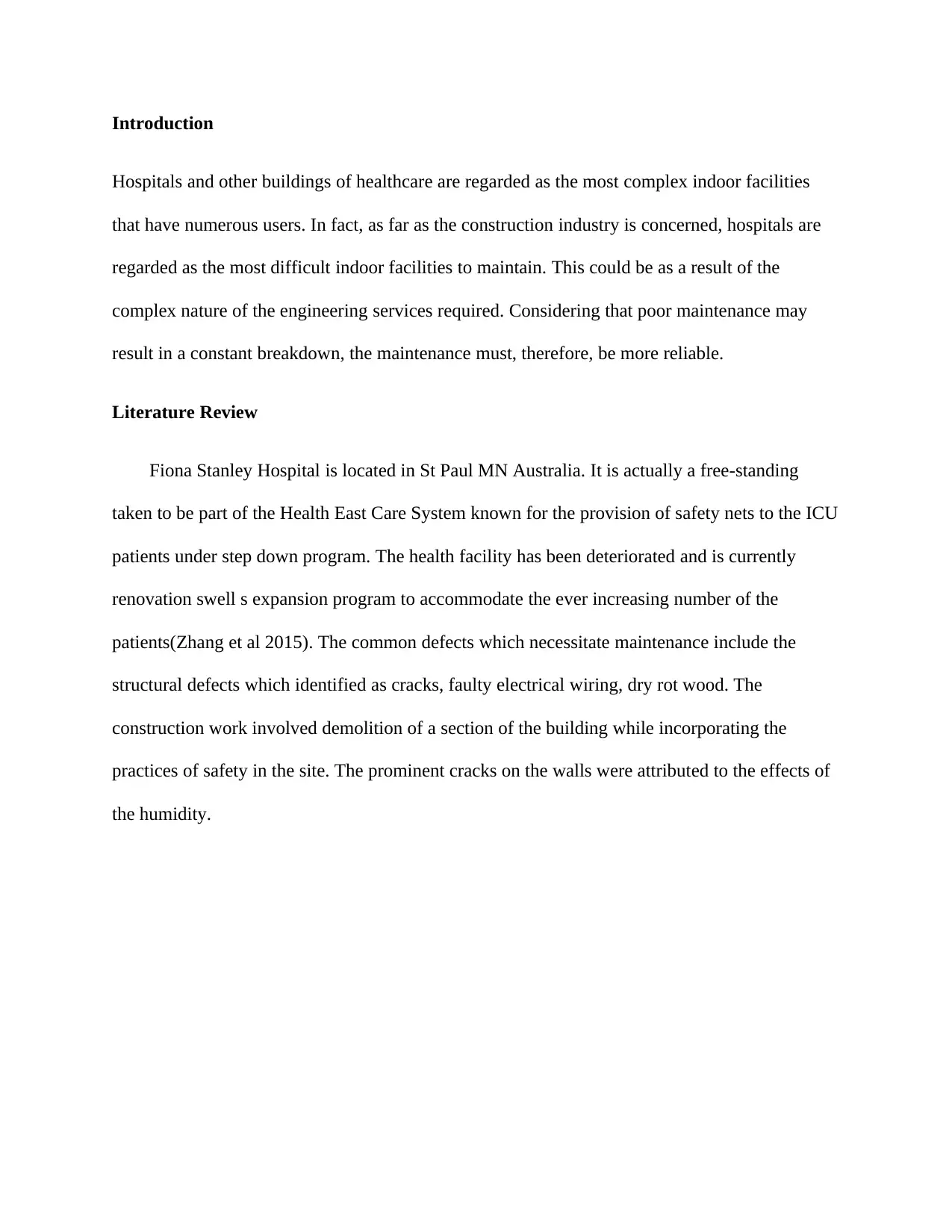
Introduction
Hospitals and other buildings of healthcare are regarded as the most complex indoor facilities
that have numerous users. In fact, as far as the construction industry is concerned, hospitals are
regarded as the most difficult indoor facilities to maintain. This could be as a result of the
complex nature of the engineering services required. Considering that poor maintenance may
result in a constant breakdown, the maintenance must, therefore, be more reliable.
Literature Review
Fiona Stanley Hospital is located in St Paul MN Australia. It is actually a free-standing
taken to be part of the Health East Care System known for the provision of safety nets to the ICU
patients under step down program. The health facility has been deteriorated and is currently
renovation swell s expansion program to accommodate the ever increasing number of the
patients(Zhang et al 2015). The common defects which necessitate maintenance include the
structural defects which identified as cracks, faulty electrical wiring, dry rot wood. The
construction work involved demolition of a section of the building while incorporating the
practices of safety in the site. The prominent cracks on the walls were attributed to the effects of
the humidity.
Hospitals and other buildings of healthcare are regarded as the most complex indoor facilities
that have numerous users. In fact, as far as the construction industry is concerned, hospitals are
regarded as the most difficult indoor facilities to maintain. This could be as a result of the
complex nature of the engineering services required. Considering that poor maintenance may
result in a constant breakdown, the maintenance must, therefore, be more reliable.
Literature Review
Fiona Stanley Hospital is located in St Paul MN Australia. It is actually a free-standing
taken to be part of the Health East Care System known for the provision of safety nets to the ICU
patients under step down program. The health facility has been deteriorated and is currently
renovation swell s expansion program to accommodate the ever increasing number of the
patients(Zhang et al 2015). The common defects which necessitate maintenance include the
structural defects which identified as cracks, faulty electrical wiring, dry rot wood. The
construction work involved demolition of a section of the building while incorporating the
practices of safety in the site. The prominent cracks on the walls were attributed to the effects of
the humidity.
⊘ This is a preview!⊘
Do you want full access?
Subscribe today to unlock all pages.

Trusted by 1+ million students worldwide
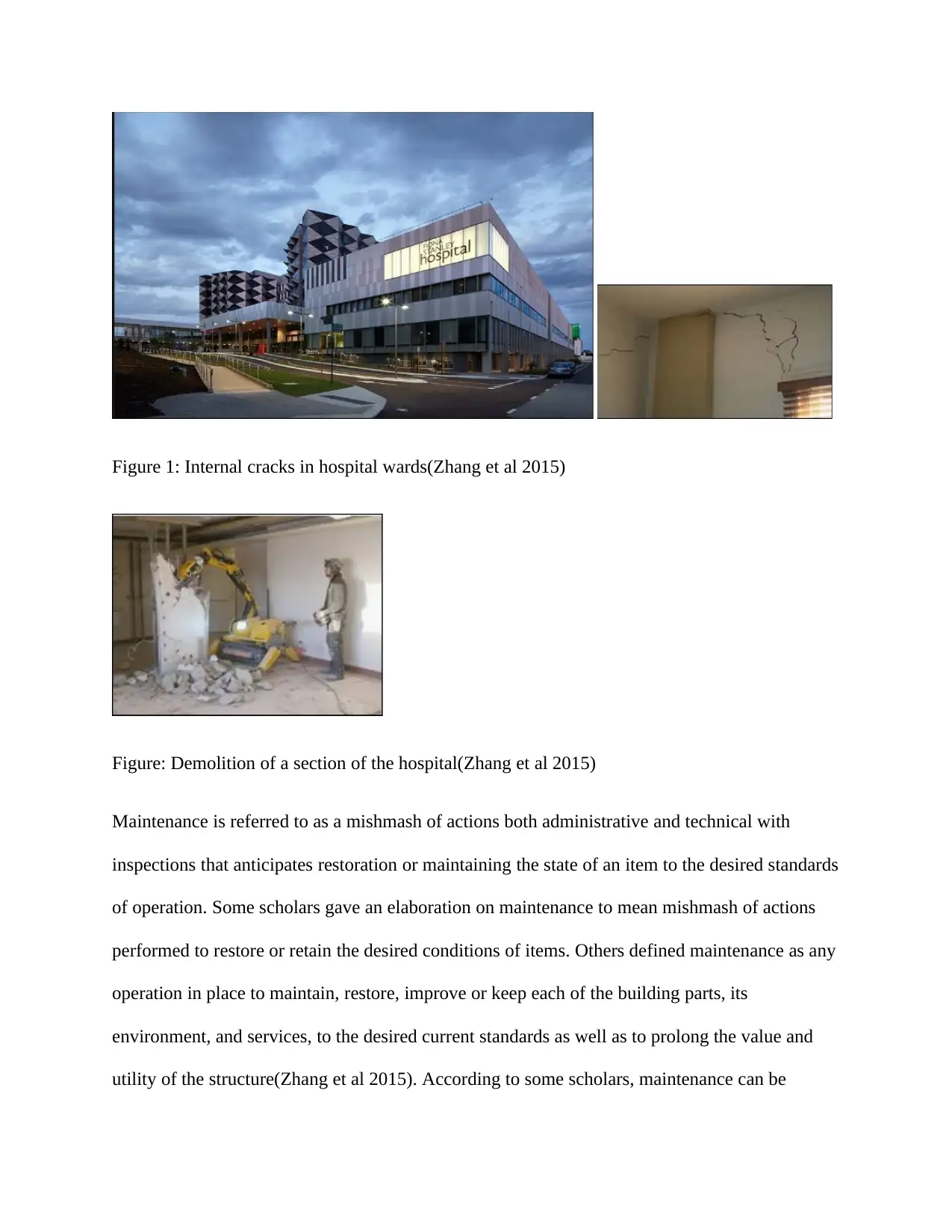
Figure 1: Internal cracks in hospital wards(Zhang et al 2015)
Figure: Demolition of a section of the hospital(Zhang et al 2015)
Maintenance is referred to as a mishmash of actions both administrative and technical with
inspections that anticipates restoration or maintaining the state of an item to the desired standards
of operation. Some scholars gave an elaboration on maintenance to mean mishmash of actions
performed to restore or retain the desired conditions of items. Others defined maintenance as any
operation in place to maintain, restore, improve or keep each of the building parts, its
environment, and services, to the desired current standards as well as to prolong the value and
utility of the structure(Zhang et al 2015). According to some scholars, maintenance can be
Figure: Demolition of a section of the hospital(Zhang et al 2015)
Maintenance is referred to as a mishmash of actions both administrative and technical with
inspections that anticipates restoration or maintaining the state of an item to the desired standards
of operation. Some scholars gave an elaboration on maintenance to mean mishmash of actions
performed to restore or retain the desired conditions of items. Others defined maintenance as any
operation in place to maintain, restore, improve or keep each of the building parts, its
environment, and services, to the desired current standards as well as to prolong the value and
utility of the structure(Zhang et al 2015). According to some scholars, maintenance can be
Paraphrase This Document
Need a fresh take? Get an instant paraphrase of this document with our AI Paraphraser
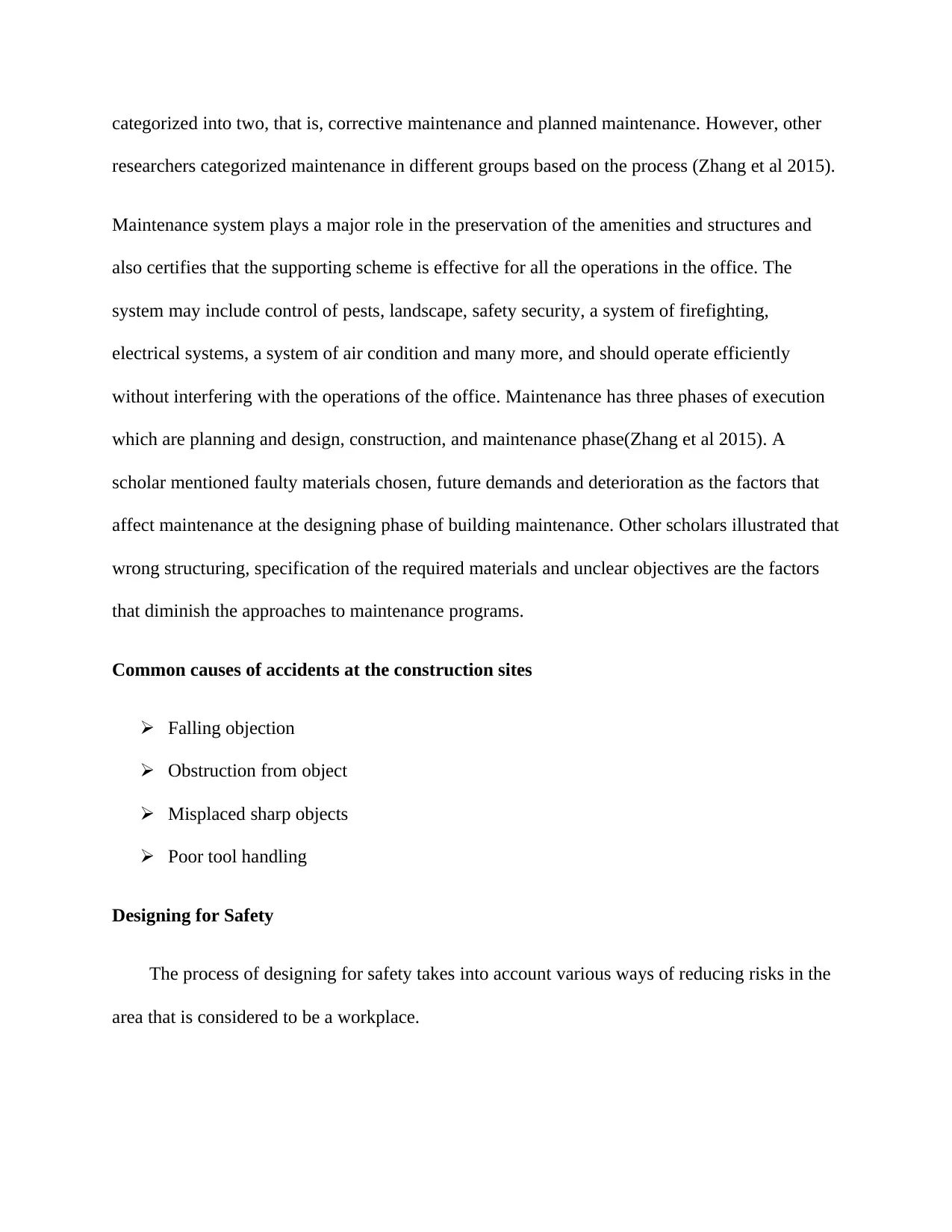
categorized into two, that is, corrective maintenance and planned maintenance. However, other
researchers categorized maintenance in different groups based on the process (Zhang et al 2015).
Maintenance system plays a major role in the preservation of the amenities and structures and
also certifies that the supporting scheme is effective for all the operations in the office. The
system may include control of pests, landscape, safety security, a system of firefighting,
electrical systems, a system of air condition and many more, and should operate efficiently
without interfering with the operations of the office. Maintenance has three phases of execution
which are planning and design, construction, and maintenance phase(Zhang et al 2015). A
scholar mentioned faulty materials chosen, future demands and deterioration as the factors that
affect maintenance at the designing phase of building maintenance. Other scholars illustrated that
wrong structuring, specification of the required materials and unclear objectives are the factors
that diminish the approaches to maintenance programs.
Common causes of accidents at the construction sites
Falling objection
Obstruction from object
Misplaced sharp objects
Poor tool handling
Designing for Safety
The process of designing for safety takes into account various ways of reducing risks in the
area that is considered to be a workplace.
researchers categorized maintenance in different groups based on the process (Zhang et al 2015).
Maintenance system plays a major role in the preservation of the amenities and structures and
also certifies that the supporting scheme is effective for all the operations in the office. The
system may include control of pests, landscape, safety security, a system of firefighting,
electrical systems, a system of air condition and many more, and should operate efficiently
without interfering with the operations of the office. Maintenance has three phases of execution
which are planning and design, construction, and maintenance phase(Zhang et al 2015). A
scholar mentioned faulty materials chosen, future demands and deterioration as the factors that
affect maintenance at the designing phase of building maintenance. Other scholars illustrated that
wrong structuring, specification of the required materials and unclear objectives are the factors
that diminish the approaches to maintenance programs.
Common causes of accidents at the construction sites
Falling objection
Obstruction from object
Misplaced sharp objects
Poor tool handling
Designing for Safety
The process of designing for safety takes into account various ways of reducing risks in the
area that is considered to be a workplace.
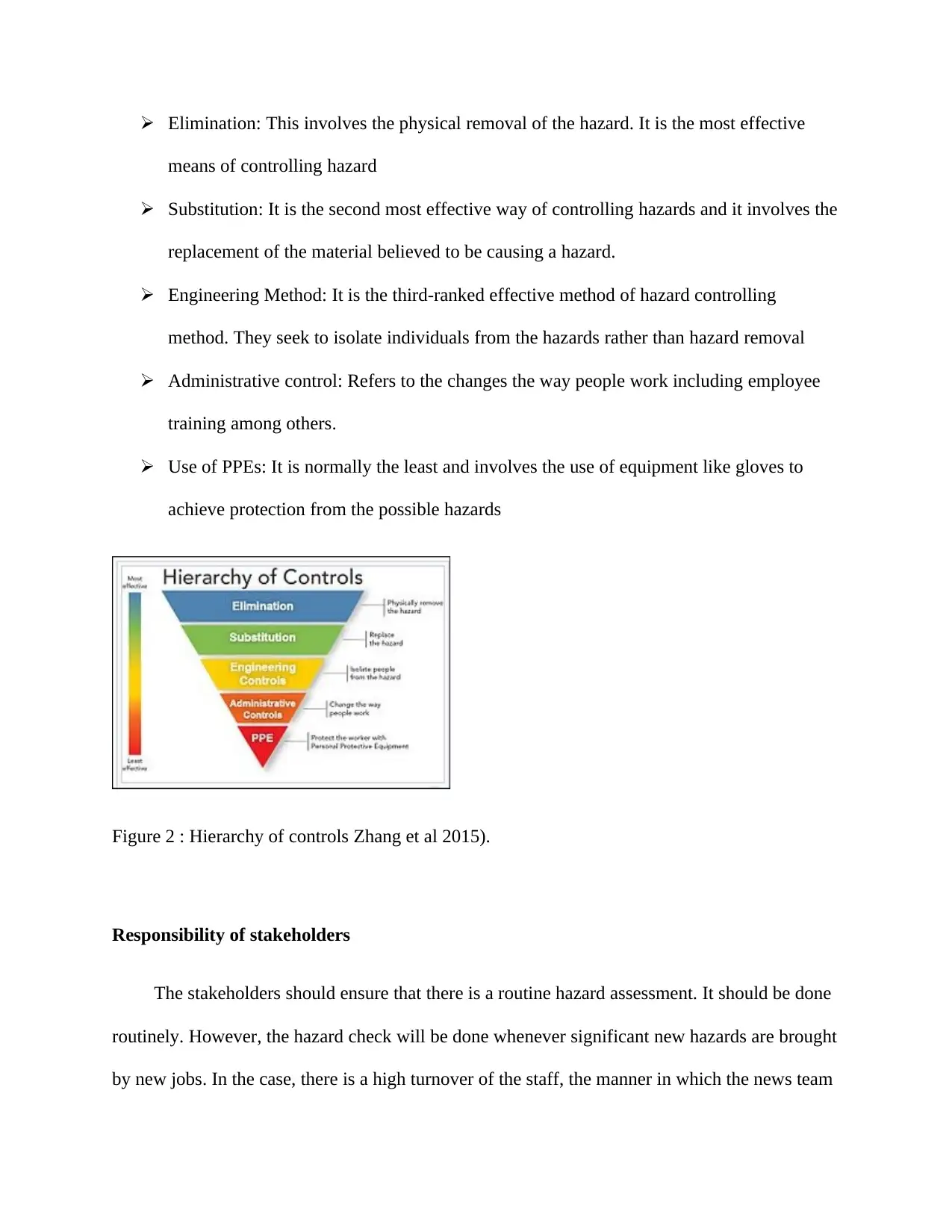
Elimination: This involves the physical removal of the hazard. It is the most effective
means of controlling hazard
Substitution: It is the second most effective way of controlling hazards and it involves the
replacement of the material believed to be causing a hazard.
Engineering Method: It is the third-ranked effective method of hazard controlling
method. They seek to isolate individuals from the hazards rather than hazard removal
Administrative control: Refers to the changes the way people work including employee
training among others.
Use of PPEs: It is normally the least and involves the use of equipment like gloves to
achieve protection from the possible hazards
Figure 2 : Hierarchy of controls Zhang et al 2015).
Responsibility of stakeholders
The stakeholders should ensure that there is a routine hazard assessment. It should be done
routinely. However, the hazard check will be done whenever significant new hazards are brought
by new jobs. In the case, there is a high turnover of the staff, the manner in which the news team
means of controlling hazard
Substitution: It is the second most effective way of controlling hazards and it involves the
replacement of the material believed to be causing a hazard.
Engineering Method: It is the third-ranked effective method of hazard controlling
method. They seek to isolate individuals from the hazards rather than hazard removal
Administrative control: Refers to the changes the way people work including employee
training among others.
Use of PPEs: It is normally the least and involves the use of equipment like gloves to
achieve protection from the possible hazards
Figure 2 : Hierarchy of controls Zhang et al 2015).
Responsibility of stakeholders
The stakeholders should ensure that there is a routine hazard assessment. It should be done
routinely. However, the hazard check will be done whenever significant new hazards are brought
by new jobs. In the case, there is a high turnover of the staff, the manner in which the news team
⊘ This is a preview!⊘
Do you want full access?
Subscribe today to unlock all pages.

Trusted by 1+ million students worldwide
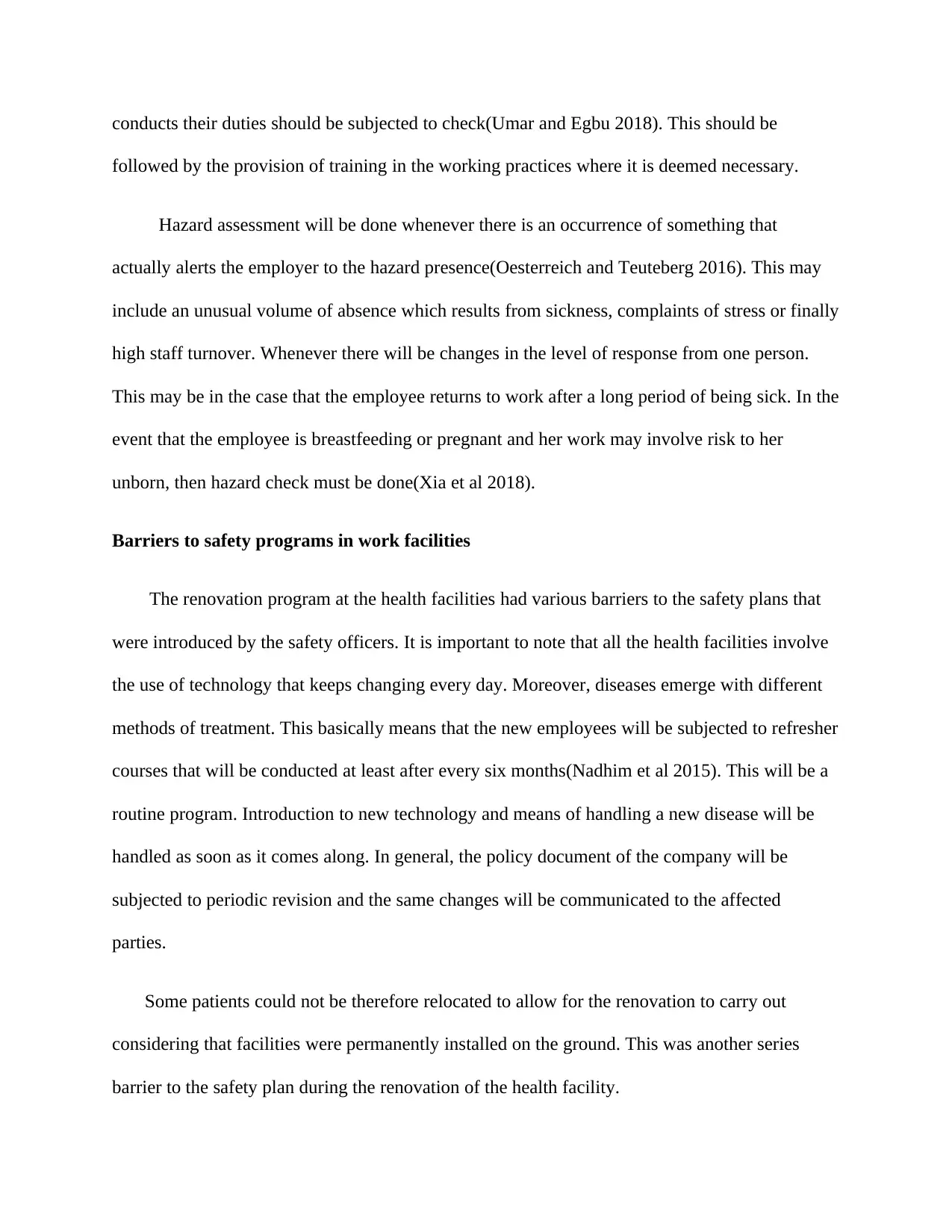
conducts their duties should be subjected to check(Umar and Egbu 2018). This should be
followed by the provision of training in the working practices where it is deemed necessary.
Hazard assessment will be done whenever there is an occurrence of something that
actually alerts the employer to the hazard presence(Oesterreich and Teuteberg 2016). This may
include an unusual volume of absence which results from sickness, complaints of stress or finally
high staff turnover. Whenever there will be changes in the level of response from one person.
This may be in the case that the employee returns to work after a long period of being sick. In the
event that the employee is breastfeeding or pregnant and her work may involve risk to her
unborn, then hazard check must be done(Xia et al 2018).
Barriers to safety programs in work facilities
The renovation program at the health facilities had various barriers to the safety plans that
were introduced by the safety officers. It is important to note that all the health facilities involve
the use of technology that keeps changing every day. Moreover, diseases emerge with different
methods of treatment. This basically means that the new employees will be subjected to refresher
courses that will be conducted at least after every six months(Nadhim et al 2015). This will be a
routine program. Introduction to new technology and means of handling a new disease will be
handled as soon as it comes along. In general, the policy document of the company will be
subjected to periodic revision and the same changes will be communicated to the affected
parties.
Some patients could not be therefore relocated to allow for the renovation to carry out
considering that facilities were permanently installed on the ground. This was another series
barrier to the safety plan during the renovation of the health facility.
followed by the provision of training in the working practices where it is deemed necessary.
Hazard assessment will be done whenever there is an occurrence of something that
actually alerts the employer to the hazard presence(Oesterreich and Teuteberg 2016). This may
include an unusual volume of absence which results from sickness, complaints of stress or finally
high staff turnover. Whenever there will be changes in the level of response from one person.
This may be in the case that the employee returns to work after a long period of being sick. In the
event that the employee is breastfeeding or pregnant and her work may involve risk to her
unborn, then hazard check must be done(Xia et al 2018).
Barriers to safety programs in work facilities
The renovation program at the health facilities had various barriers to the safety plans that
were introduced by the safety officers. It is important to note that all the health facilities involve
the use of technology that keeps changing every day. Moreover, diseases emerge with different
methods of treatment. This basically means that the new employees will be subjected to refresher
courses that will be conducted at least after every six months(Nadhim et al 2015). This will be a
routine program. Introduction to new technology and means of handling a new disease will be
handled as soon as it comes along. In general, the policy document of the company will be
subjected to periodic revision and the same changes will be communicated to the affected
parties.
Some patients could not be therefore relocated to allow for the renovation to carry out
considering that facilities were permanently installed on the ground. This was another series
barrier to the safety plan during the renovation of the health facility.
Paraphrase This Document
Need a fresh take? Get an instant paraphrase of this document with our AI Paraphraser
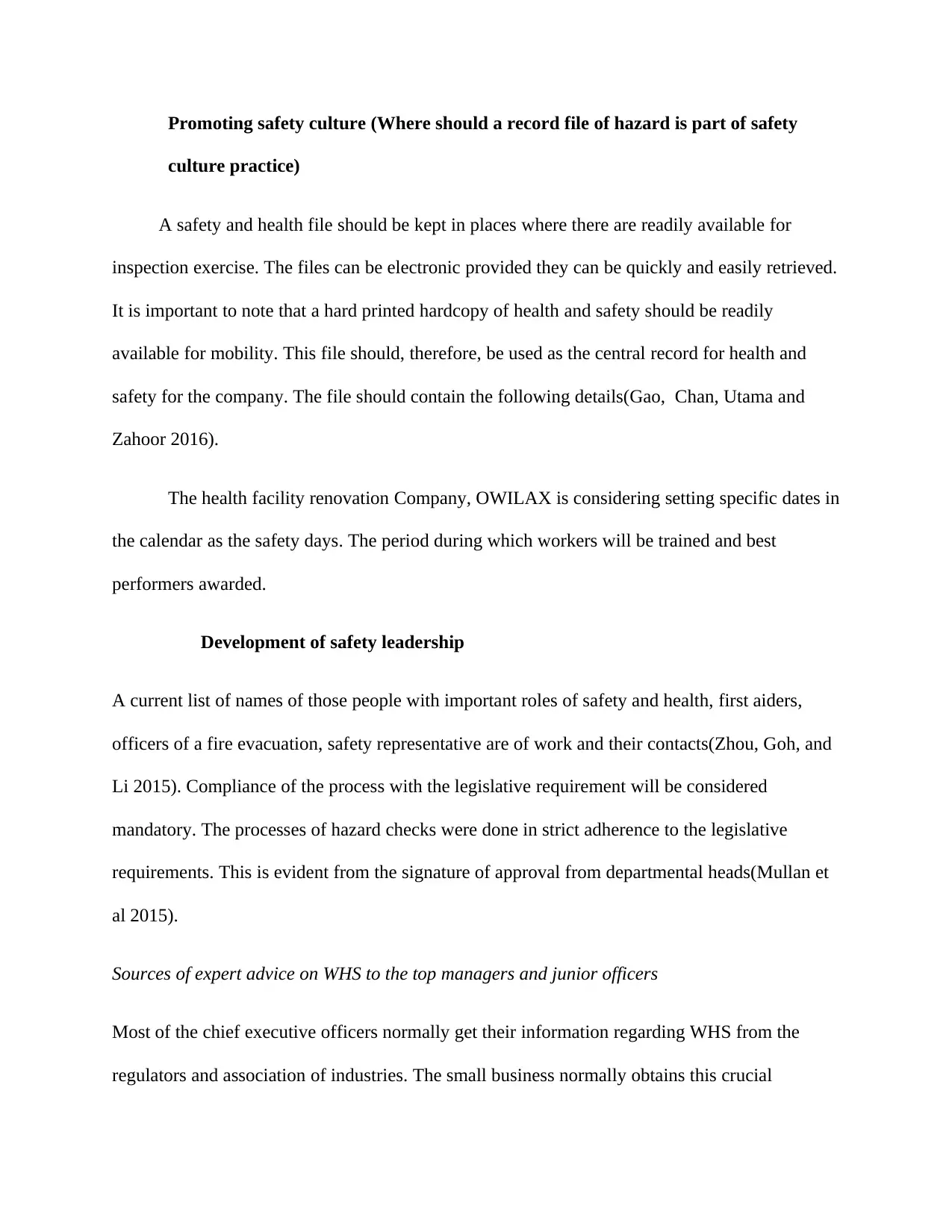
Promoting safety culture (Where should a record file of hazard is part of safety
culture practice)
A safety and health file should be kept in places where there are readily available for
inspection exercise. The files can be electronic provided they can be quickly and easily retrieved.
It is important to note that a hard printed hardcopy of health and safety should be readily
available for mobility. This file should, therefore, be used as the central record for health and
safety for the company. The file should contain the following details(Gao, Chan, Utama and
Zahoor 2016).
The health facility renovation Company, OWILAX is considering setting specific dates in
the calendar as the safety days. The period during which workers will be trained and best
performers awarded.
Development of safety leadership
A current list of names of those people with important roles of safety and health, first aiders,
officers of a fire evacuation, safety representative are of work and their contacts(Zhou, Goh, and
Li 2015). Compliance of the process with the legislative requirement will be considered
mandatory. The processes of hazard checks were done in strict adherence to the legislative
requirements. This is evident from the signature of approval from departmental heads(Mullan et
al 2015).
Sources of expert advice on WHS to the top managers and junior officers
Most of the chief executive officers normally get their information regarding WHS from the
regulators and association of industries. The small business normally obtains this crucial
culture practice)
A safety and health file should be kept in places where there are readily available for
inspection exercise. The files can be electronic provided they can be quickly and easily retrieved.
It is important to note that a hard printed hardcopy of health and safety should be readily
available for mobility. This file should, therefore, be used as the central record for health and
safety for the company. The file should contain the following details(Gao, Chan, Utama and
Zahoor 2016).
The health facility renovation Company, OWILAX is considering setting specific dates in
the calendar as the safety days. The period during which workers will be trained and best
performers awarded.
Development of safety leadership
A current list of names of those people with important roles of safety and health, first aiders,
officers of a fire evacuation, safety representative are of work and their contacts(Zhou, Goh, and
Li 2015). Compliance of the process with the legislative requirement will be considered
mandatory. The processes of hazard checks were done in strict adherence to the legislative
requirements. This is evident from the signature of approval from departmental heads(Mullan et
al 2015).
Sources of expert advice on WHS to the top managers and junior officers
Most of the chief executive officers normally get their information regarding WHS from the
regulators and association of industries. The small business normally obtains this crucial
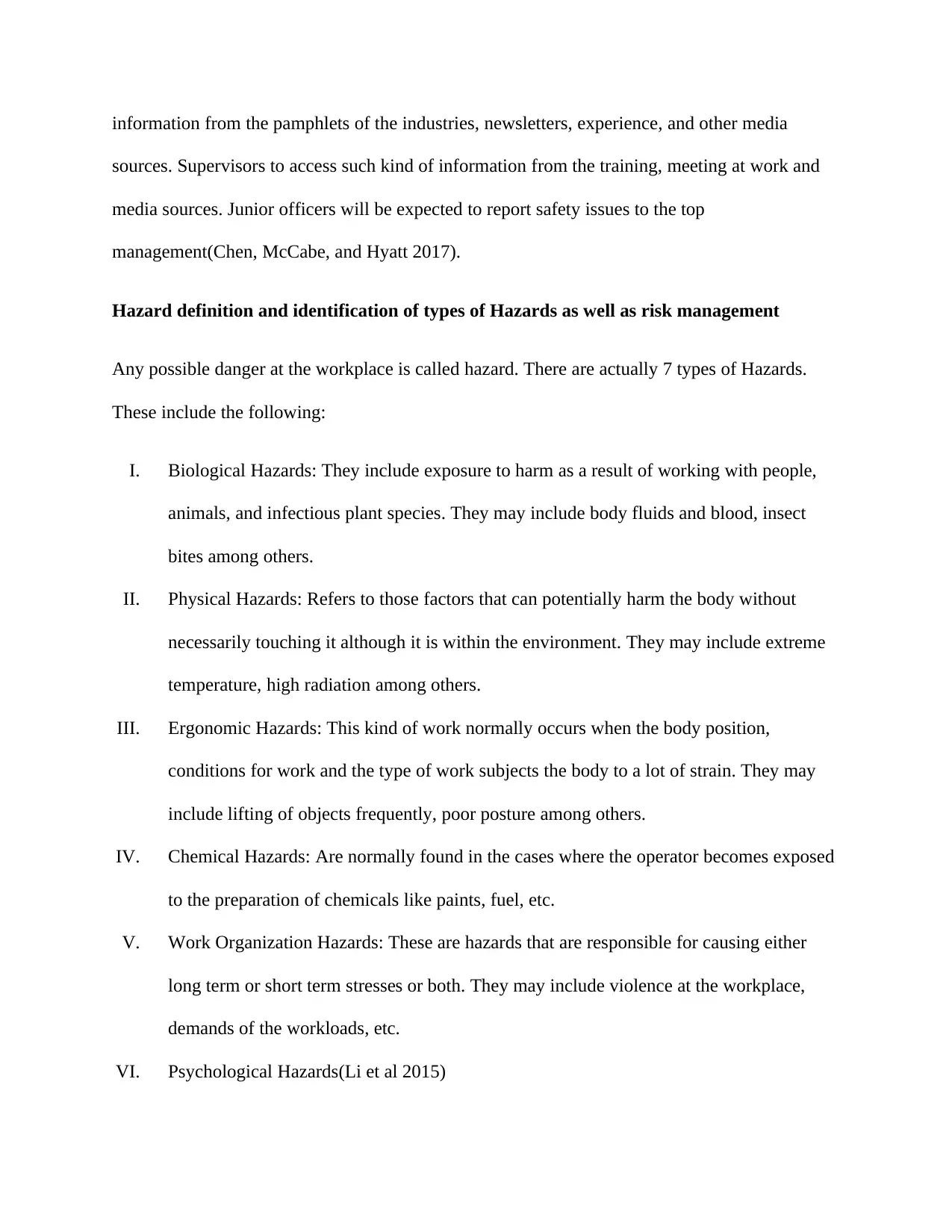
information from the pamphlets of the industries, newsletters, experience, and other media
sources. Supervisors to access such kind of information from the training, meeting at work and
media sources. Junior officers will be expected to report safety issues to the top
management(Chen, McCabe, and Hyatt 2017).
Hazard definition and identification of types of Hazards as well as risk management
Any possible danger at the workplace is called hazard. There are actually 7 types of Hazards.
These include the following:
I. Biological Hazards: They include exposure to harm as a result of working with people,
animals, and infectious plant species. They may include body fluids and blood, insect
bites among others.
II. Physical Hazards: Refers to those factors that can potentially harm the body without
necessarily touching it although it is within the environment. They may include extreme
temperature, high radiation among others.
III. Ergonomic Hazards: This kind of work normally occurs when the body position,
conditions for work and the type of work subjects the body to a lot of strain. They may
include lifting of objects frequently, poor posture among others.
IV. Chemical Hazards: Are normally found in the cases where the operator becomes exposed
to the preparation of chemicals like paints, fuel, etc.
V. Work Organization Hazards: These are hazards that are responsible for causing either
long term or short term stresses or both. They may include violence at the workplace,
demands of the workloads, etc.
VI. Psychological Hazards(Li et al 2015)
sources. Supervisors to access such kind of information from the training, meeting at work and
media sources. Junior officers will be expected to report safety issues to the top
management(Chen, McCabe, and Hyatt 2017).
Hazard definition and identification of types of Hazards as well as risk management
Any possible danger at the workplace is called hazard. There are actually 7 types of Hazards.
These include the following:
I. Biological Hazards: They include exposure to harm as a result of working with people,
animals, and infectious plant species. They may include body fluids and blood, insect
bites among others.
II. Physical Hazards: Refers to those factors that can potentially harm the body without
necessarily touching it although it is within the environment. They may include extreme
temperature, high radiation among others.
III. Ergonomic Hazards: This kind of work normally occurs when the body position,
conditions for work and the type of work subjects the body to a lot of strain. They may
include lifting of objects frequently, poor posture among others.
IV. Chemical Hazards: Are normally found in the cases where the operator becomes exposed
to the preparation of chemicals like paints, fuel, etc.
V. Work Organization Hazards: These are hazards that are responsible for causing either
long term or short term stresses or both. They may include violence at the workplace,
demands of the workloads, etc.
VI. Psychological Hazards(Li et al 2015)
⊘ This is a preview!⊘
Do you want full access?
Subscribe today to unlock all pages.

Trusted by 1+ million students worldwide
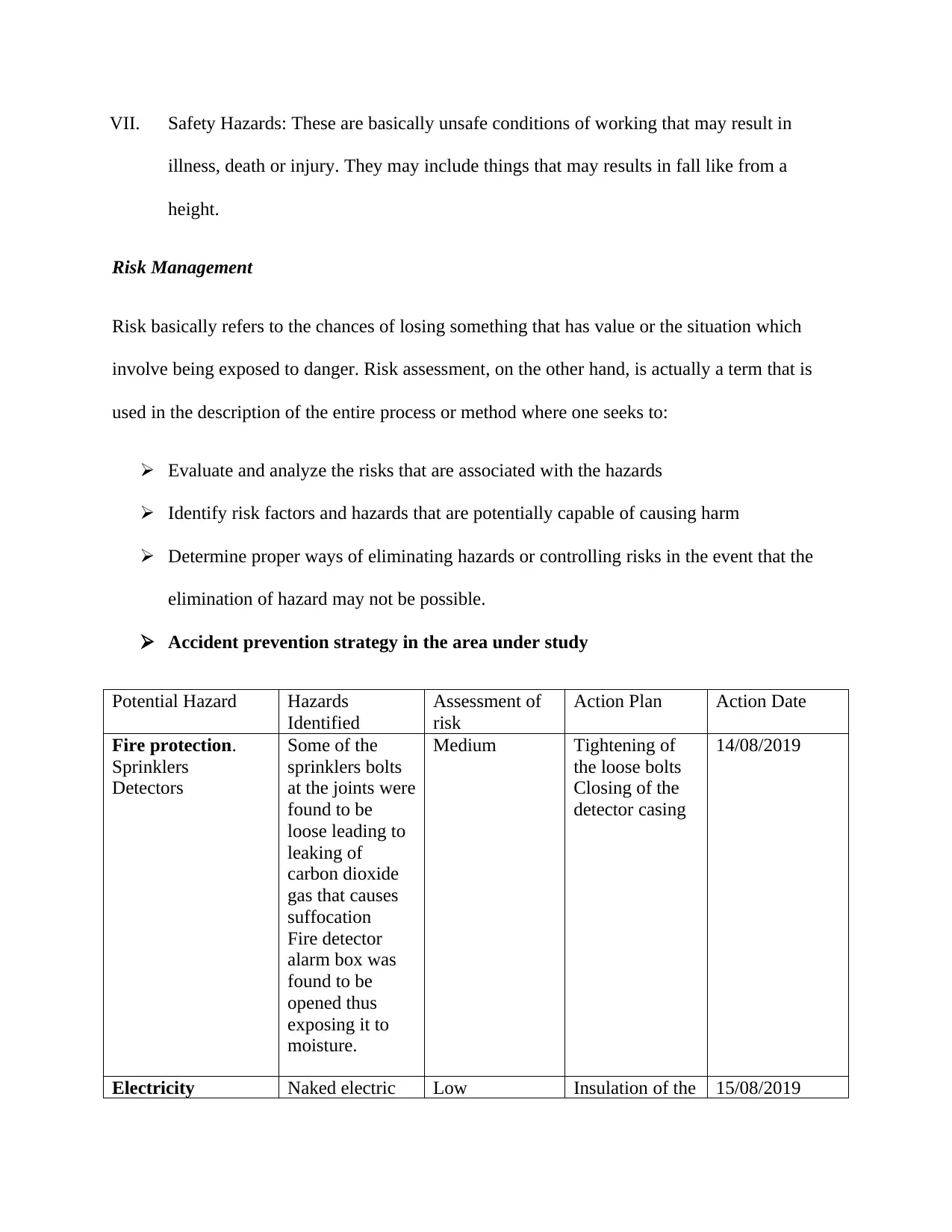
VII. Safety Hazards: These are basically unsafe conditions of working that may result in
illness, death or injury. They may include things that may results in fall like from a
height.
Risk Management
Risk basically refers to the chances of losing something that has value or the situation which
involve being exposed to danger. Risk assessment, on the other hand, is actually a term that is
used in the description of the entire process or method where one seeks to:
Evaluate and analyze the risks that are associated with the hazards
Identify risk factors and hazards that are potentially capable of causing harm
Determine proper ways of eliminating hazards or controlling risks in the event that the
elimination of hazard may not be possible.
Accident prevention strategy in the area under study
Potential Hazard Hazards
Identified
Assessment of
risk
Action Plan Action Date
Fire protection.
Sprinklers
Detectors
Some of the
sprinklers bolts
at the joints were
found to be
loose leading to
leaking of
carbon dioxide
gas that causes
suffocation
Fire detector
alarm box was
found to be
opened thus
exposing it to
moisture.
Medium Tightening of
the loose bolts
Closing of the
detector casing
14/08/2019
Electricity Naked electric Low Insulation of the 15/08/2019
illness, death or injury. They may include things that may results in fall like from a
height.
Risk Management
Risk basically refers to the chances of losing something that has value or the situation which
involve being exposed to danger. Risk assessment, on the other hand, is actually a term that is
used in the description of the entire process or method where one seeks to:
Evaluate and analyze the risks that are associated with the hazards
Identify risk factors and hazards that are potentially capable of causing harm
Determine proper ways of eliminating hazards or controlling risks in the event that the
elimination of hazard may not be possible.
Accident prevention strategy in the area under study
Potential Hazard Hazards
Identified
Assessment of
risk
Action Plan Action Date
Fire protection.
Sprinklers
Detectors
Some of the
sprinklers bolts
at the joints were
found to be
loose leading to
leaking of
carbon dioxide
gas that causes
suffocation
Fire detector
alarm box was
found to be
opened thus
exposing it to
moisture.
Medium Tightening of
the loose bolts
Closing of the
detector casing
14/08/2019
Electricity Naked electric Low Insulation of the 15/08/2019
Paraphrase This Document
Need a fresh take? Get an instant paraphrase of this document with our AI Paraphraser
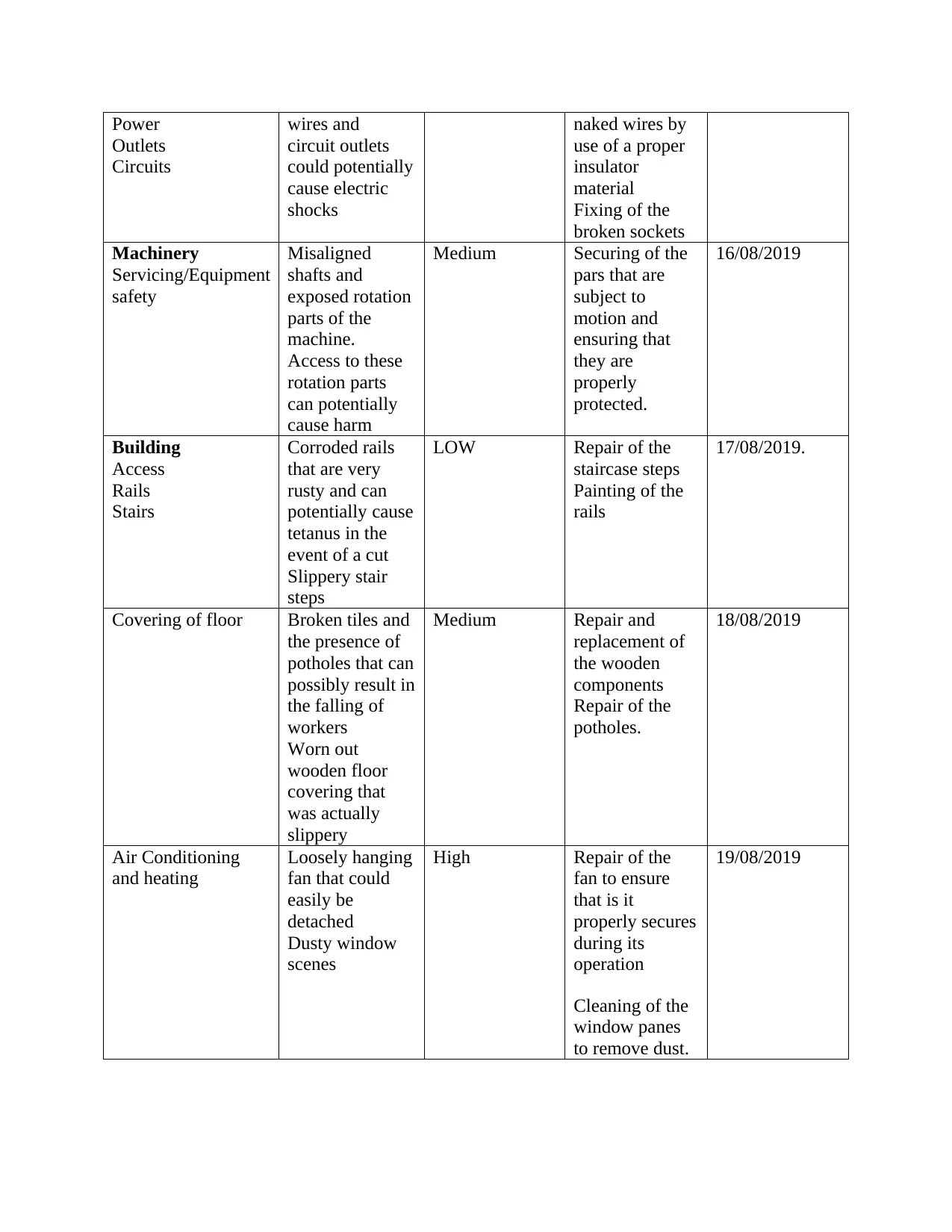
Power
Outlets
Circuits
wires and
circuit outlets
could potentially
cause electric
shocks
naked wires by
use of a proper
insulator
material
Fixing of the
broken sockets
Machinery
Servicing/Equipment
safety
Misaligned
shafts and
exposed rotation
parts of the
machine.
Access to these
rotation parts
can potentially
cause harm
Medium Securing of the
pars that are
subject to
motion and
ensuring that
they are
properly
protected.
16/08/2019
Building
Access
Rails
Stairs
Corroded rails
that are very
rusty and can
potentially cause
tetanus in the
event of a cut
Slippery stair
steps
LOW Repair of the
staircase steps
Painting of the
rails
17/08/2019.
Covering of floor Broken tiles and
the presence of
potholes that can
possibly result in
the falling of
workers
Worn out
wooden floor
covering that
was actually
slippery
Medium Repair and
replacement of
the wooden
components
Repair of the
potholes.
18/08/2019
Air Conditioning
and heating
Loosely hanging
fan that could
easily be
detached
Dusty window
scenes
High Repair of the
fan to ensure
that is it
properly secures
during its
operation
Cleaning of the
window panes
to remove dust.
19/08/2019
Outlets
Circuits
wires and
circuit outlets
could potentially
cause electric
shocks
naked wires by
use of a proper
insulator
material
Fixing of the
broken sockets
Machinery
Servicing/Equipment
safety
Misaligned
shafts and
exposed rotation
parts of the
machine.
Access to these
rotation parts
can potentially
cause harm
Medium Securing of the
pars that are
subject to
motion and
ensuring that
they are
properly
protected.
16/08/2019
Building
Access
Rails
Stairs
Corroded rails
that are very
rusty and can
potentially cause
tetanus in the
event of a cut
Slippery stair
steps
LOW Repair of the
staircase steps
Painting of the
rails
17/08/2019.
Covering of floor Broken tiles and
the presence of
potholes that can
possibly result in
the falling of
workers
Worn out
wooden floor
covering that
was actually
slippery
Medium Repair and
replacement of
the wooden
components
Repair of the
potholes.
18/08/2019
Air Conditioning
and heating
Loosely hanging
fan that could
easily be
detached
Dusty window
scenes
High Repair of the
fan to ensure
that is it
properly secures
during its
operation
Cleaning of the
window panes
to remove dust.
19/08/2019
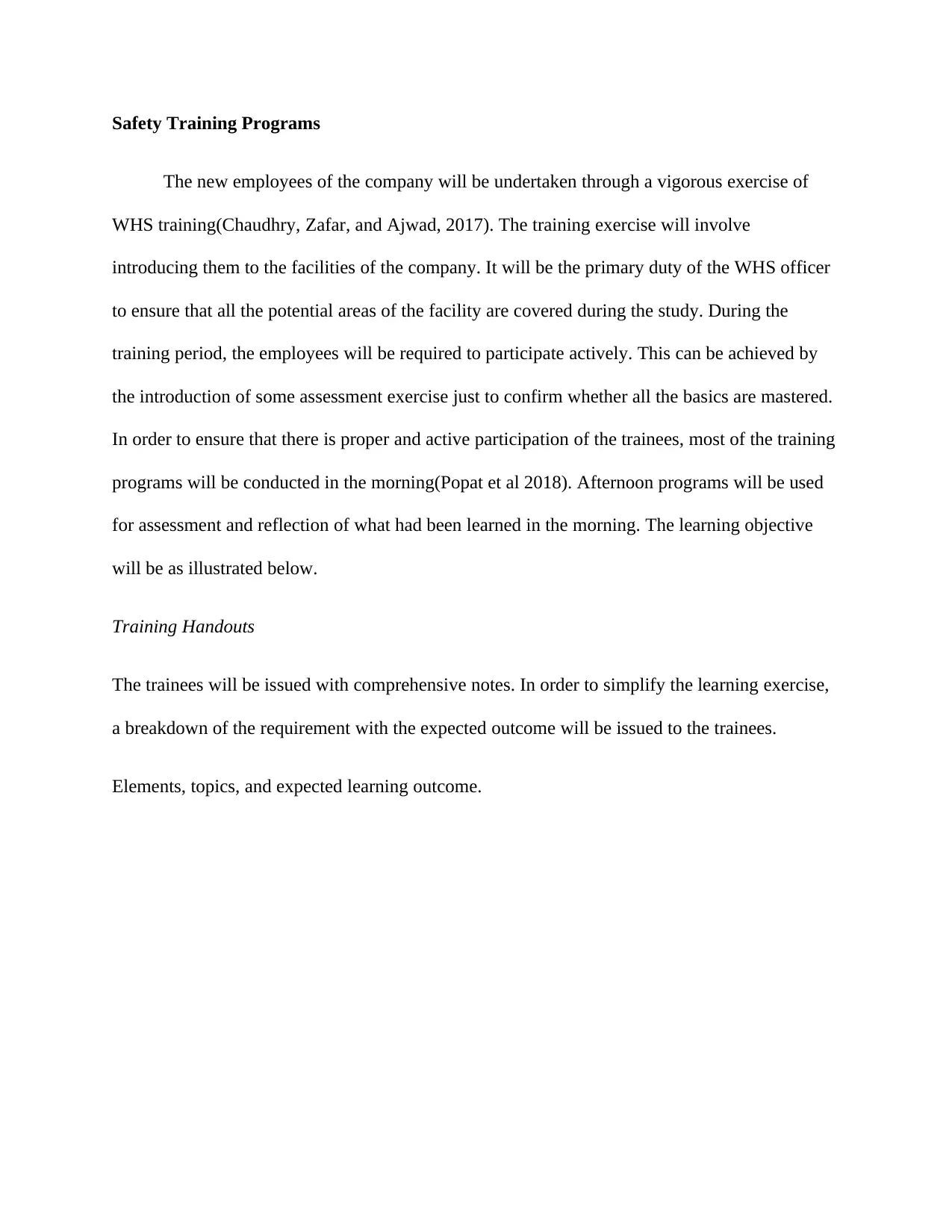
Safety Training Programs
The new employees of the company will be undertaken through a vigorous exercise of
WHS training(Chaudhry, Zafar, and Ajwad, 2017). The training exercise will involve
introducing them to the facilities of the company. It will be the primary duty of the WHS officer
to ensure that all the potential areas of the facility are covered during the study. During the
training period, the employees will be required to participate actively. This can be achieved by
the introduction of some assessment exercise just to confirm whether all the basics are mastered.
In order to ensure that there is proper and active participation of the trainees, most of the training
programs will be conducted in the morning(Popat et al 2018). Afternoon programs will be used
for assessment and reflection of what had been learned in the morning. The learning objective
will be as illustrated below.
Training Handouts
The trainees will be issued with comprehensive notes. In order to simplify the learning exercise,
a breakdown of the requirement with the expected outcome will be issued to the trainees.
Elements, topics, and expected learning outcome.
The new employees of the company will be undertaken through a vigorous exercise of
WHS training(Chaudhry, Zafar, and Ajwad, 2017). The training exercise will involve
introducing them to the facilities of the company. It will be the primary duty of the WHS officer
to ensure that all the potential areas of the facility are covered during the study. During the
training period, the employees will be required to participate actively. This can be achieved by
the introduction of some assessment exercise just to confirm whether all the basics are mastered.
In order to ensure that there is proper and active participation of the trainees, most of the training
programs will be conducted in the morning(Popat et al 2018). Afternoon programs will be used
for assessment and reflection of what had been learned in the morning. The learning objective
will be as illustrated below.
Training Handouts
The trainees will be issued with comprehensive notes. In order to simplify the learning exercise,
a breakdown of the requirement with the expected outcome will be issued to the trainees.
Elements, topics, and expected learning outcome.
⊘ This is a preview!⊘
Do you want full access?
Subscribe today to unlock all pages.

Trusted by 1+ million students worldwide
1 out of 18
Your All-in-One AI-Powered Toolkit for Academic Success.
+13062052269
info@desklib.com
Available 24*7 on WhatsApp / Email
![[object Object]](/_next/static/media/star-bottom.7253800d.svg)
Unlock your academic potential
Copyright © 2020–2025 A2Z Services. All Rights Reserved. Developed and managed by ZUCOL.